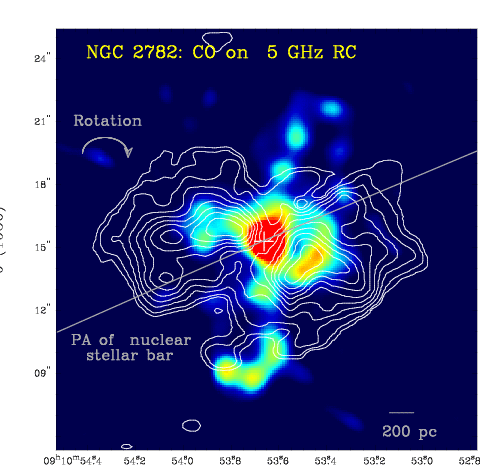A nuclear bar feeding molecular gas into a powerful central starburst in
NGC 2782
The study of dynamical processes which channel gas towards the center
of galaxies is central to understanding nearby starbursts and AGN, as well
as more distant UILRGs and QSOs. Nuclear bars nested within the primary
bar and nuclear spirals have been proposed as mechanisms for driving
gas further in, feeding central starbursts and AGN.
OVRO CO (1--0) observations of NGC 2782 (Jogee, Kenney, & Smith 1998; 1999)
provide one of the first direct observational evidence of a nuclear stellar
bar feeding molecular gas to a powerful M82-class starburst (Fig. 1). The CO
morphology and kinematics, the large molecular dynamical mass fraction, the
angle between the stellar and the molecular bar, the steeply rising rotation
curve, and large estimated nuclear bar pattern speed in NGC 2782 are
consistent
with the theoretical predictions of decoupled nuclear bars
(Shlosman et al. 1989; Friedli & Martinet 1993; Maciejewski & Sparke 2000;
Shlosman & Heller 2002). Currently underway are comparisons of OVRO CO observations of double-bar systems such as NGC 2782, NGC 3368, NGC 4314, and
NGC 5929 (Jogee et al. 2003 in prep.) with recent simulations of gas
flow patterns in nested bar systems (Shlosman & Heller 2002).
For details see
Jogee, S., Kenney, J. D. P., & Smith, B. J. 1999, ApJ, 526, 665
(astro-ph/9907085):
A nuclear bar feeding molecular gas into a powerful central starburst in
NGC 2782
Jogee, S., Kenney, J. D. P., & Smith, B. J. 1998, ApJL, 494, L185:
The remarkable starburst-driven outflow in NGC 2782
Smith, B. J., Curtis, S., Kenney, J. D. P., & Jogee, S. 1999,
AJ, 117, 1237:
The Molecule-rich tail of the peculiar galaxy NGC 2782 (Arp 215)

